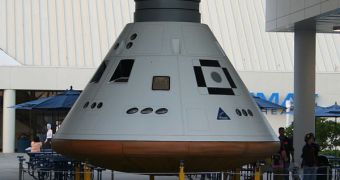On July 11th, NASA is scheduled to conduct a test flight of the ARES I-X prototype, designed to ensure that the construction is feasible, and that the delivery system can indeed carry people and hardware safely to orbit, and then to the Moon or Mars. For this very purpose, a mock-up of the future Orion Crew Transport Vehicle arrived at the Kennedy Space Center on Wednesday, alongside the launch abort system. Both dummy segments will be loaded on top of a four-stage booster. The fifth stage will also be a mock-up, designed to test how the lifting platform handles weight and aerodynamics.
During the July test, the rocket's parachute recovery system and the first / second stage separation systems will be tested, in the first of four flight safety tests that will precede the launch of an actual Orion capsule into orbit. This particular mission will cost some $360 million, but experts at NASA say that the money will be well worth it, considering the implications of the success. Also, if it succeeds, it will prove critics who say that the rocket is too slender wrong, and will open up a new avenue of space exploration, which could see people on the Moon again by 2020.
The current launch is designed to test both aerodynamics traits and crew safety. Mock-ups of the astronauts will also be placed inside Orion, and mission controllers will analyze all the conditions they are subjected to, to determine if actual humans could withstand the stress. Also, the vibrations caused by launching a booster will be thoroughly measured, and their impact on the entire structure further assessed. Even if the flight were to fail, it would still be a victory, mainly because no one would die, but also because the causes that could trigger a catastrophe would be suppressed for the next test.
The only thing that stands in the way of the July test is the planned Hubble Space Telescope repair mission, which requires both launch pads at the KSC. And although the two are some 3 months apart, it takes 4 to 5 months to reconfigure the launch pad to house the new ARES I-X mission. A decision on the matter will be taken in March, but NASA representatives are pondering the possibility of having the second shuttle on stand-by off the launch pad, and to move it on only if the situation requires it. This would virtually leave the other pad opened for the ARES mission.

 14 DAY TRIAL //
14 DAY TRIAL //